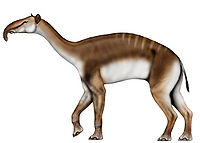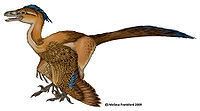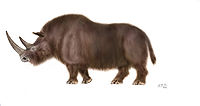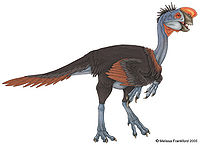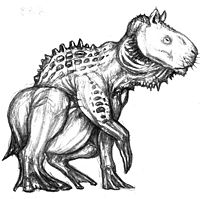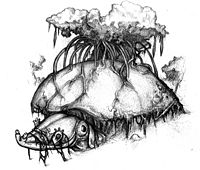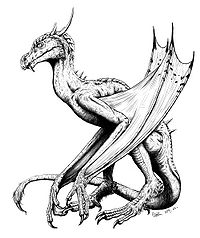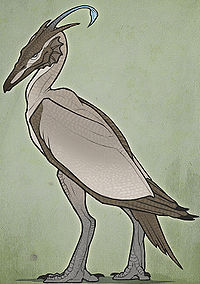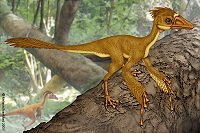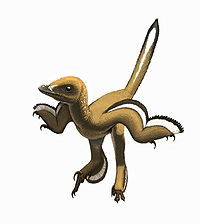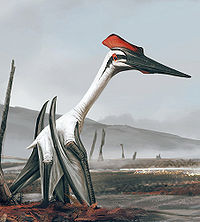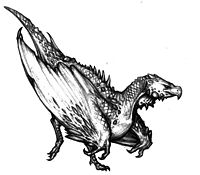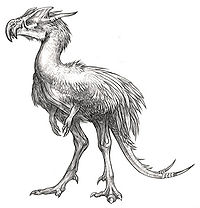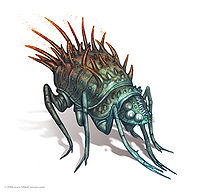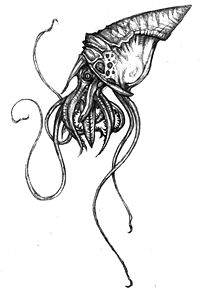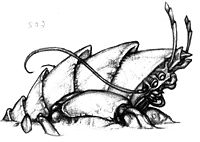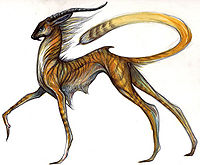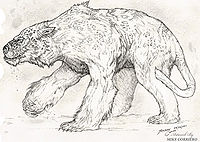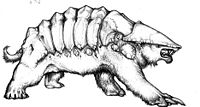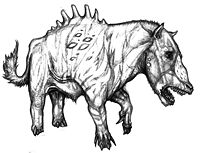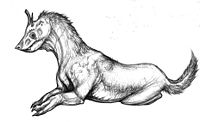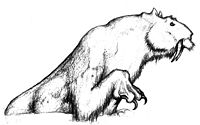From OtherSpace: Encyclopedia Galactica
Contents
Domesticated Animals
Food Animals
- Unguli – Roaming in schools of up to a thousand, these quick, aerodynamic eight inch circular herbivorous invertibrates feature twelve triangular paddles and a solar organ for breaking up water into breathable elements. They are farmed in shallow ocean waters of temperate regions.
- Zik - The main meat animal of Pyracan, it was once a herding grasslands animal and a very distant relative to the Satai. Thousands of years of selective breeding have allowed the ungulates to survive in almost any environment. They have also evolved a trust for Rickirr, which have been used to protect Zik since prehistory. Zik stand about four feet tall, with a short trunk used to strip leaves and pull up grasses, a long neck, rhinoceros-like feet, short brown fur with subtle striping near the rump, and a white underside.
Mounts
- Rickirr – 6-8 foot tall bipedal feathered lizard, originally used for herding, and now used as a quick and agile mount.
- Satai – A six foot tall shaggy rhinoceros-like creature, once used as a plow animal, but now used as a sturdy long-distance mount.
Other
- Cotallach – A cross between a slug and a clam, this two foot long slithering bivalve retreats back into its shell at the first sign of danger. Originally, it existed in a complex relationship with ribeiasc, receiving protection from bolgs and other predators in exchange for their creation of nutrient-rich pearls for the ribeiasc to eat. The Pyracani domesticated the cotallach around 500 AD, and through selective breeding, created varieties that coated objects in salt, magnesium, sulfur, and even a crude glass.
Wild Animals
Avian-Reptilians
- Angler - Three feet tall, this flightless, gray-skinned avian-reptilian features brown feathers on the body and crest, burnt orange wing- and tailtips, and bright orange eyes, waddle and facial crest. It uses its shovel-like beak to create tide pools in the sides of moving streams, baiting them with bugs, then eating fish as they come to claim the bait. Its population has grown over the last hundred years, with the extinction of the starracht.
- Beabhiasc – Found in marshlands the world over, these hardy avian-reptilians have fine, downy gray and white feathers only on their heads, with the rest of their body having crude gray scales. They make grass-lined burrows in marsh banks, with their only entrance found underwater, and eat a variety of aquatic vegetation. The claws of their webbed hind legs extrude a poison when the beabhiasc senses danger that causes breathing trouble and lethargy.
- Cranniasc – A distant cousin of the avian-reptilians, these foot-long marsh dwellers look like a cross between a fish and a turtle, with a characteristic deep orange shrub emerging from their backs as a warning that they're poisonous. At birth, cranniasc mothers force several seeds into the newborn’s soft shell, providing dung and water until a small shrub emerges. This shrub serves two main purposes: first, to provide vital nutrients to the cranniasc via bacteria that live on the shrub’s roots, and second, to provide protection, as the shrub is extremely toxic to eat, and even leeches some of its poison into the cranniasc’s skin. It has extended nostrils so that it can remain completely submerged in the water save for the shrub. It feeds on water insects and plants.
- Daja - With a height of over nine feet and a wingspan near thirty, this scaly-skinned heather-gray avian-reptilian has two swept-back horns and a line of spine ridges, with thin gray pinfeathers lining its legs and tailtip. Its long, serpentine tail ends in a tough, sharp claw, used to stab other males in dominance fights. It has been known to pick up prey over thirty pounds in weight and fly away with it, and thus can only be found in the most remote mountains, having been hunted out of existence in populated areas.
- Feonadh – With gray feathers and standing almost six feet high, this extremely intelligent, opportunistic omnivore eats almost anything, including fruits, nuts, mollusks, worms, seeds, eggs, fish, biorr shoots, and carrion, but is best known for its innovative ambushes. Solitary feonadh have been known to disguise mud pits with leaves, bend back and secure biorr stalks to make them smack passersby, cut and place biorr stalks to create a crude cattle chute to chase prey into, place biorr stalks like fences in streams to corral fish, throw small objects into bushes to misdirect prey, and even laying appropriate bait to lure prey. In 2596, a feonadh apparently placed a silver necklace on leaves floating on a mud pit to lure an elderly Pyracani with a metal detector to the pit, then ate him while he was incapacitated. Because of stories like this, feonadhs have been purged from almost all inhabited areas, and now only inhabit the wildest of biorr forests or a few select hunting sanctuaries.
- Meirle - Six inches in height, this flightless avian-reptilian features yellowish-brown skin, golden-brown feathers, and a light goldenrod underside. Omnivores, this jungle-dwelling opportunist eats bugs, berries, and is well-known for its boldness in stealing eggs of creatures much larger than itself.
- Meirfe - Brown, flying relatives of the meirle vaguely the size of large dragonflies, native to equatorial seasides.
- Misg - Standing around four feet in height, this is a distant cousin to the much more successful group of avian-reptilians, with a hard beak and no wing-claws. It has dark gray skin, a long pointed beak, a swept-back red crest, tiny white feathers and a black streak going from its beak across its eye and down its long neck. It is awkward on land, known to waddle drunkenly, but is quite graceful in both sea and air, diving to catch small fish in its long beak. It is found in equatorial jungles.
- Seabhairt - Fast both in the air and in the water, these three pound jungle-dwelling avian-reptilians have hooked gray beaks, dark brown plumage and cream-colored bellies, and hunt fish exclusively. They have been known to steal kills from buafshuigh, with their speed and small size helping them avoid the larger beast’s tentacles. Their feathers are often used in Pyracani sciaths and jewelry.
- Sealg - A distant cousin to the Daja, this flightless avian-reptilian is approximately six feet in height, with gray skin and reddish-brown feathers. It features two swept-back head ridges, two horns, a blunt snout with several overlapping facial projections, two tiny, useless forelimbs, and long, powerful legs. It can be found in grasslands, where it sprints up to forty miles an hour to run down prey, using its tooth-like projections to hold the victim down while it kicks it to death.
Bugs
- Caisearr - A two inch long pollinating beetle covered in yellow, feather-like growths that help it collect pollen to spread. When threatened, it puffs up the feathers to make it more than three times its usual size, and thus very difficult to swallow whole.
- Danadas – A four foot long predatory millipede that lives in the arctic oceans, known for its boldness in attacking prey much larger than itself.
- Gazriki - A two foot long brown flea-like insect that preys on the blood of zik and Pyracani. Extremely rare, but sometimes found in places of filth.
- Korole - Shaped like a three foot reddish-brown praying mantis, it is known for its ability to convincingly portray a piece of seaweed, and making its exoskeleton more pliable so as to flow in the movement of the water. Found in temperate ocean shallows.
- Matchbeetle - A two inch long, six-legged insect, it is an icy blue-gray-green near its head tapering back to a dark blue gray towards its hind end, with over a dozen long spikes on its hindquarters that change from blue-gray to fiery orange when it feels threatened, creating a chemical reaction that makes the spikes heat to over six hundred degrees. Pyracani survivalists often set out capture-traps of iadh for these insects for their help in starting campfires. They are found in equatorial jungles.
- Siocharc – Lithe and graceful, these yellow and brown striped two foot tall high-jumping beetles feature long legs and a large white Y-shaped horn, and are found the world round. While mostly harmless to Pyracani, these gazriki relatives are often considered a pest due to their smelly dung and their willingness to steal food from Pyracani if desperate, though they’re typically found feasting on roadkill.
Cephalopods
- Bolg – Found in equatorial oceans, this is a five foot long white tentacled animal shaped vaguely like a cross between a sea cucumber and a dirigible. A long oily stripe across their backs allows them to absorb sunlight and use the energy to break water into hydrogen and oxygen. The hydrogen is stored in a long gasbag, allowing them to fly above the water looking for prey, while the oxygen is slowly expelled out the back to allow for movement. When prey is found, the hydrogen is quickly dispelled, and the bolg drops down upon the prey, using its gigantic mouth to swallow it whole along with a good amount of sea water to start the floating process once more.
- Buafshuigh - Resembling an eight foot long leathery squid with bumps of protective cartilage surrounding its 'head', this army-green predator anchors itself amidst grinneall trees in shallow equatorial waters by pushing six of its tentacles deep into the sand, then waits for prey, sometimes for weeks. When an animal comes near, the buafshuigh strikes quickly with its two fore tentacles, lifting the creature out of the water and constricting it until it is dead. It swallows its prey whole, and is able to stretch to fit prey over twice its size, including Pyracani.
- Crucashuigh - Known as a firework bolg though it is only a distant cousin, this thirty foot long seagoing cephalopod is known for its spectacular light shows during its mating season, and its mother-of-pearl hooks that it sinks into its prey. Native to the Murra Ocean, thousands of the gigantic beasts gather once a year to compete for mates in breathtaking displays of stationary fireworks as far as the eye can see. Killing the cephalopod while it is glowing and sparking freezes the pattern on its skin, and it would continue to glow at night once dead when exposed to the sun. This created a large market in glowing clothing and other goods. After years of hemming and hawing on the issue, the Pyracan government banned the hunting of this animal in 2554 after it became seriously endangered, but fortunately, tourism of the events bring in more money than hunting ever did.
- Jegoro – The largest land animal on Pyracan, this ten-legged, five ton dark gray invertibrate behemoth with a single short gray horn looks like a cross between a squid and an elephant, and lives near the base of mountains in Chiarrain Nation. It utilizes its two massive front tentacles to pull biorr or large ferns from the ground and rips them into pieces to eat. While herbivorous, jegoro are still quite dangerous when threatened. It has become somewhat rare due to being hunted for its tough, flexible skin, which is used for backing armor. They have proven nearly impossible to domesticate, though it has been tried many times.
- Levicera – Ten foot long squid-like predator with its head hidden within a whorled shell with a wicked point. Tends to stab its prey, and then use its tentacles to draw the innards out for consumption. Lives in arctic oceans.
- Puinsean - Looking somewhat like an airborne, brightly color-shifting squid, this six inch long omnivore is highly poisonous. It exists in a sort of symbiotic relationship with the saighead flower, using the 1-2 gallon pools of water in the massive upturned flowers to power its hydrogen balloon-like flight and eating the floating dead insects that collect in these pools. In return, it both pollinates the flowers and poisons the pool so the flower can collect more insects and absorb some of the protein as the insects decay. It lives in equatorial jungles.
Crustaceans
- Falbhann – Looking like a cross between a starfish and a turtle, this twelve-legged crustacean is known as a slow but relentless predator, and almost impossible to kill while in the water. Its extremely hard shell is very difficult to crack, and it can lose a significant amount of its body and still be able to fully regenerate. It has been known to single-mindedly follow prey for weeks, outlasting instead of outrunning. It lives on equatorial seashores.
- Portanamh - Reaching almost five feet in length, this solitary, nomadic omnivore is one of the largest crustaceans on Pyracan. While these soft-shelled light turquoise invertebrates spend the vast majority of their lives out in open ocean, they travel up the equatorial river of their birth several times during their lives for mating and burying of eggs in the river’s muddy banks.
- Ribeiasc – Colloquially known as the Flockless or the Fisherman’s Friend, these three foot long intelligent arthropods historically herded cotallach in shallow, tropical seas, protecting them from bolg in exchange for their nutritious pearls. However, as wild cotallach went extinct over a thousand years ago, they now crowd near docks and other places where society and the sea overlap, eating a wide variety of trash and fishing byproducts. These fifty pound beasts are occasionally kept as pets by sailors, as they can often learn tricks and are very loving.
- Seapairr - Reaching almost four feet in length, these lazy, slow-moving gray-green crustaceans use their long upper limbs and strong claws to hang from biorr in the upper canopy of the forest for days at a time. They constantly munch on nearby sticks and leaves, only moving when they’ve defoliated an area. They live in temperate biorr forests.
- Seisd - About two feet in length, this squat black herbivorous crustacean uses its thick, sharp slicing arms to fell biorr and its dual tails to draw up piles of dirt to create enormous warrens for its extended family. While normally shy and fearful of Pyracani contact, it will use its slicing arms to fight to the death to protect its offspring. They live in temperate biorr forests.
- Zuni - Vaguely resembling a cross between a monkey and a spider, this foot-tall, 12-legged brachiate may be the most agile thing in the forest. Its six long, skinny upper legs are used to propel it through the dense vertical shafts of the temperate biorr forests at speeds of up to 50 miles per hour. Zuni are often kept as pets by wealthier Pyracani, and can be trained to do tricks. Stone gray with light brown stomachs in the wild, it’s been bred into various patterns of blue-gray, gray, black, white, tan, brown, and greenish-brown.
Fish
- Daicheill - A bright red eel with electric blue flukes, it is said to have soft, succulent flesh, though the presence of a poison gland in the head tends to limit its distribution to those trained in removing the gland. Mildly popular as a large aquarium fish for its attractive coloration and streaks of electric blue bioluminescence, though it tends to kill most other fish, whether by its aggressive nature or the realease of poison in close quarters. Lives in the equatorial oceans.
- Dathte - With ragged metallic blue-on-white bull's-eye coloration on each flank like a tie-dye shirt, this six inch long fish escapes predators both through its sparkling-water camoflauge and its ability to jump and glide via its long fins, often for hundreds of feet. It is found in the oceans of Cuirrc Nation.
- Leisg - A two foot pink manta-like fish that hides from predators by burying itself amidst the sand in the shallow waters of Cuirrc Nation. The most popular seafood on Pyracan for its dense flesh and natural stick to hold it by for grilling and eating.
- Mairr - Found in the deep ocean, these fifty plus foot whale-like, gigantic distant cousins of the Rickirr use modified feathers over their gaping mouths to filter out microorganisms from the water, and use their long taloned forefins to dislodge parasites and to defend themselves against predators.
- Meanan - A common bait amongst fishermen, these lithe, four inch metallic teal fish gather in huge numbers in estuaries, where saltwater meets fresh. They are found the world over.
- Saill - Over ten feet in length and blubbery, these gray-blue arctic avian-like fish are caught for their blubber, which is used for frying a variety of dishes, being neutral in flavor.
- Salanas - A three foot long yellow and lime green striped fish with three large, showy yellow frills running the length of its head and long, lacy fins. Known as good eating, and found around Cuirrc Nation.
Mammals
- Acladh - Eating grasses, shrubs, and the clipped-off biorr twig leftovers from seapairr, this spry, three foot tall ruminant travels in herds of up to a dozen, never staying in the same place for more than a day. As it is extremely difficult to track down and kill, has stringy, mildly toxic meat, and a pelt unsuited to tanning, the term 'acladh hunter' has become derogatory slang for someone who hunts only for trophies and status, and thus dishonors his kill.
- Andarct - Seven foot tall omnivorous bear-wolf in patchy shades of gold, brown and tan. A distant relative of Pyracani. Lives where grasslands and forests meet the world over.
- Broctiubh – Found on jungle floors, these two foot insectivores are known for their extremely tough armor plates, said to even be able to shrug off plasma fire, and their general unwillingness to die. They use their sharp claws to break into insect mounds, and make nests in the thickest of briar patches.
- Cragrinn - Standing approximately three feet in height, these cagey, herbivorous quadrupeds roam the jungle floor in herds of 6-10, feeding on tough shoots and fallen fruit and possessing a surprisingly high intelligence. While typically a ruddy brown with an ochre belly, they are known to have a high rate of albinism, and the pink-eyed, white-furred albinos are a favorite of hunters both as a means to keep the species healthy and because the animals give an especially difficult chase.
- Cuarracht - A relative of the andarct and almost as infamous, it is a dark gray bear-wolf approximately seven feet in length and over 250 lbs that lives in preas trees in the equatorial jungles of Pyracan. It is a nocturnal stalk-and-ambush type predator that uses its powerful bite and wicked claws to quickly dispatch prey and drag them up to the cuarracht's treetop nest.
- Cumada - The closest living relative to the Pyracani, these rare, three foot long jungle-dwellers mainly feed on the poisonous puinsean, batting the blimps out of the air with acrobatic leaps and swipes, and washing their kills in the sea to dilute its poison. These fearless carnivores have even been known to go after buafshuigh when food is scarce. They have tan fur with sienna streaks, and short, brown horns.
- Dallag – Foot-tall tan with dark brown stripes meercat-like burrowing rodents that make their homes in equatorial sand dunes.
- Itealaich – Resembling a black kangaroo rat, this biorr-climbing rodent’s tail is tightly folded behind it like a fan. When it senses danger, it jumps and fans open the stretchy tail into a parachute so it can travel safely down to the forest floor.
Single-Celled Organisms
- Malaya – Stretching sometimes for thousands of acres, herds of this small bright green, eel-like single-celled organism are a major pest to the Pyracani, as the inedible blobs clog nets and kill sea life. When their main predator, the bolg, was nearly wiped out a few hundred years ago, the creatures began to multiply unchecked, and now require yearly management to prevent them from choking off popular beach sites. They live in equatorial oceans.
- Iadh - Like an inch-long translucent eel, these gossamer green amoebas move via rippling their amazingly thin bodies like flags on a windy day. In a poorly-understood phenomenon, they absorb algae into themselves and somehow co-opt the plants’ powers of photosynthesis. In ancient times, the iadh were tied heavily to fairy stories, and some Pyracani are superstitious about large clouds of iadh to this day. They live in grasslands the world over.
Legends
- Aureus Lake Wyrm - First allegedly seen on June 6th, 2653, the Aureus Lake Wyrm is approximately fifty feet in length, its body about eight feet in diameter. It's segmented body has two pairs of legs for each section, each leg ending in a single spiked tip. It has a broad set of mandibles which are sharp and jagged where they meet. The creature has no perceivable eyes or external sensory organs. It may live in a cave at the bottom of the lake, having come up to the volcanic crater from deep within the planet's crust.
- Starracht – A relative of the andarct, these slender, four foot long marine bear-wolves had rippling patterns of white, tan and brown fur and long sabre teeth, and have been thought to be extinct since 2520, though unsubstantiated sightings have been reported several times since then. Once inhabiting tropical rivers worldwide, they had small eyes, but a sense of smell so well-developed that they could track fish underwater, as well as the ability to quickly leap out of the water from total submersion fast enough to catch an angler. They used their long sabre teeth both to stab their prey and in dominance fights between males.
